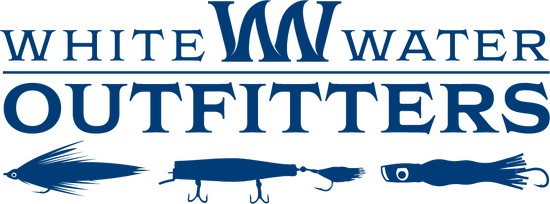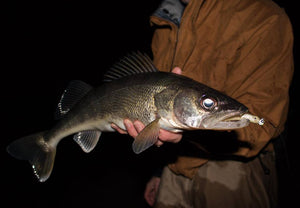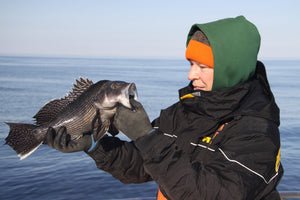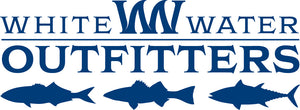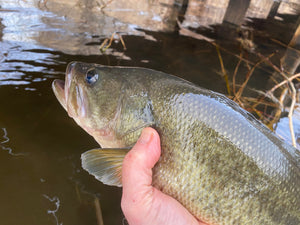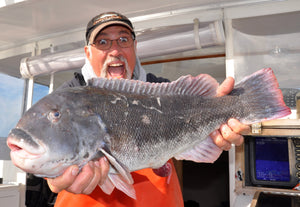Turks & Caicos Adventure

Like many of you, the staff here at White Water Outfitters is always looking to find that next out of the way fishing hot spot. If it just happens to be in a tropical paradise, so much the better. Thus, it was that our own Jeff Lomonaco and his fiancée, Alanna found themselves on a Turks and Caicos adventure this past December
If you’re not familiar with this comparatively small tropical archipelago consisting of 40 low-laying coral islands and sand banks situated just south of the Bahamas, it’s certainly worth researching. Beautiful ocean beaches await, along with plenty of great dining opportunities, tons of shopping and all the touristy things you might want to try out in warm Caribbean waters like jet skiing, wildlife viewing, sailing around on Hobie Cats, ATV tours, kayaking, clear-bottom boating, or simply spending some down time at the beach or a Tiki bar. In short, it’s a great place to kick back, relax and have a little fun. The fact that the waters here also offer some interesting bonefishing prospects makes it even more alluring for those who consider wetting a line a primary form of recreation and relaxation.
“This is a fun place, whether fishing or not,” says Jeff. “We actually found it surprisingly touristy in a good way, with nice hotels, an abundance of great restaurants, plus some really interesting shopping opportunities in an area called Grace Bay. We stayed on the gateway island of Providenciales, commonly referred to as “Provo.””

Many of the flats in the sound and "lakes" offer lush mangrove nurseries that are prime feeding grounds for bonefish.
As far as the fishing goes, Jeff notes you’ll find solid prospects for both guided trips and DYI bonefishing here, especially on the south side of Provo. If you want to try some bonefishing on your own, start at Juba Sound, he suggests. The sound has both attached and adjacent “lakes,” and its shallow waters attract a significant number of the silver ghosts. “Before you head out, however, know that these back-country waters are an interconnected system of flats,” advises Jeff. “They are ringed by mangroves and can be muddy in areas, so you may have to muck through some stretches to reach the most productive flats. The trek is worth it, though, because the bones love this kind of water as it holds a ton of fodder and prey.”
You’ll definitely want to wear a pair of zippered wading boots back in these small bays to fend off the corals and mangrove roots. That way you’ll be able to concentrate more on your casting than your footing while moving about, an important point since you’ll want to pull the trigger quickly should you intercept some bones - a distinct possibility as soon as you enter the water. “On one solo sunrise wade session in Flamingo Lake,” recalls Jeff, “I found several groups of bones tailing and cruising in the shallows. I must have seen 40 to 50 fish of mixed sizes up to 4 or 5 pounds in a little over 2 hours. That’s pretty respectable for stumbling across bonefish on your own. I was fishing in water just muddy enough to cover my feet while casting into 6- to 8-inch depths, and managed to land 5 fish. Not too shabby.”

This bonefish ate a "Feather Charlie", a variant of the classic Crazy Charlie pattern.
On another morning, while Alanna was enjoying the sunshine on a south side beach, Jeff found a nice outside beach flat that angled out toward deeper water. He walked in and eventually spied bigger bonefish - some weighing up to 8 or 9 pounds. Although he didn’t get a crack at those fish, it left him with the sense there were more large bones on the outside flats than the inside ones. “Those fish would have definitely been worth targeting,” he revealed, “but it was cool just seeing some in that size class.”
As with most tropical fishing havens, the do-it-yourself route is a great way to get to know the waters and piscatorial possibilities, but you’ll likely score better with the help of local guides when it comes to actually hooking up. To that end, Jeff and Alanna spent a few hours sampling nearby waters with local expert Capt. Darin Bain of D.B. Tours Bonefishing Charters. He’s an accomplished skipper, lobster & conch diver, plus deep sea and bottom fisherman, in addition to being a Turks and Caicos bonefishing guide.
“Indeed, we’ve got some great bonefishing here in Turks and Caicos,” says Bain, “There’s enough fish and fishable areas that you can catch some on your own – but you’ll generally do much better on the flats if you head out with a guide. For one thing, it’s tough to match the edge local knowledge provides when it comes to finding these fish. For another, on full-day trips especially, we can run you further away from the main ports to North Caicos, Middle Caicos and East Caicos where the fish are less pressured and often bigger. Even on half-day trips, we can get you over to Pine Cay and a few other hideaways, a short run east of Providenciales, where you’ll get some shots.”

Alanna's first bonefish on the guided trip with Capt. Darin.
On the boat with a guide here, bonefish average 4- to 5 pounds and run up to 10 or 12 pounds on occasion, according to Bain. He notes that while many anglers prefer to fly-fish for the bones, spin fishing is also an option with light-weight setups and soft-plastic grubs on a 3/8- to ½-ounce jighead a productive choice. If you are new to fly-fishing, you can learn on your trip and probably catch your first bonefish on your first day using the long wand. For fly patterns, Bains favors size #2 and #4 spawning or mantis shrimp, along with Clouser Minnows and sparse patterns that sport a little sparkle and a splash of orange. One of the best things about charter fishing, he reminds, is that all tackle is provided so you don’t have to bring your own rods, reels, lures, etc. Just step aboard and start fishing.

This good size bone fell for a Spawning Shrimp pattern on a DIY session. This is a top fly for fishing in the mangroves.
On his trip, Jeff took along 7- and 9-wt. flyrods but notes that a single 8-wt. would have covered all the bases. Casting a tropical floating line is a good idea, he says, since it will have a gentle taper geared for soft landings while flats fishing. For leaders, 9- to 11-foot, 12- to 16-pound-test tapered fluorocarbon is a good choice. 15 or 16 pound tippet is a good size to start with.

Alanna fighting a bonefish on a beautiful sand flat with Capt. Darin’s helpful coaching.
In terms of spinning gear, any rod that can manage the lightweight jig sizes, matched to a 2500 size reel with 10-pound-test braid and a 15 lb. fluorocarbon leader should be fine. While local guides favor 2- or 3-inch curly tail grubs, Jeff suspects 2- or 3-inch Berkley Gulp! Saltwater Shrimp, Berkley Gulp! Saltwater Peeler Crab, or a 2-inch Vudu Shrimp (if the wind is gentle) might also do well. Simple round head “freshwater” style jig heads will do the trick just fine. We tend to favor the Gamakatsu version because of the quality hook.

Sometimes it's best to keep things simple. A 3" curly-tail grub on a light jighead was all it took for Alanna to fool this one.
“I’m thinking flyrods are probably better than spinning rods here because you can make a gentler presentation with a small offering,” says Jeff. “For bonefish, accuracy counts more than distance when it comes to casting. If you can lead a fish by 3 to 5 feet on a 30 to 40-foot cast, you’ll get your chances. At least that was the experience I had. Even here, the bones can be a bit spooky, but once they see a well-presented fly, they’ll chase it down and vacuum it up. Our charter trip was both fun and productive – Alanna landed her first-ever bonefish, and I landed one and lost one – but I’ll opt for a full-day trip next time to increase the odds of seeing some of those trophy-class brutes.”

Walking the flats solo paid off with some beautiful "average" bonefish in the mangroves.
There are a couple of points to keep in mind if you are thinking about heading off to these inviting tropical islands. First, you’ll need to purchase a fishing license before heading out to do battle. Also, it’s important to do a little research to discover which waters are open and which are closed to fishing. There are significant closed stretches on the Island’s north side as well as at Chalk Sound National Park. If you don’t plan to use a guide, advises Jeff, consider renting a car and a kayak so that you’ll be able to access more flats areas. You might even want to bring down an inflatable like Sea Eagle’s FishSUP™ 126 Inflatable Fishing Stand-Up Paddleboard. That would really increase both your stealth and range.

One last thing you might also enjoy here, suggests Jeff, is stopping in at Potcake Place K9 Rescue, a dog rescue charity on the islands. “We took a pup and walked it around the beaches for couple hours to help it get socialized,” explains Jeff. “These are adorable little puppies, anywhere from 10- to 16-weeks old, and you’ll really have a ball with them. That experience turned out to be yet another highlight of our terrific trip.”
- Bryce Poyer
